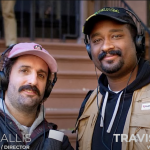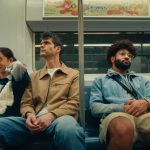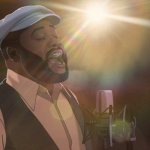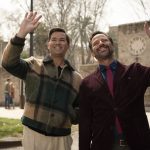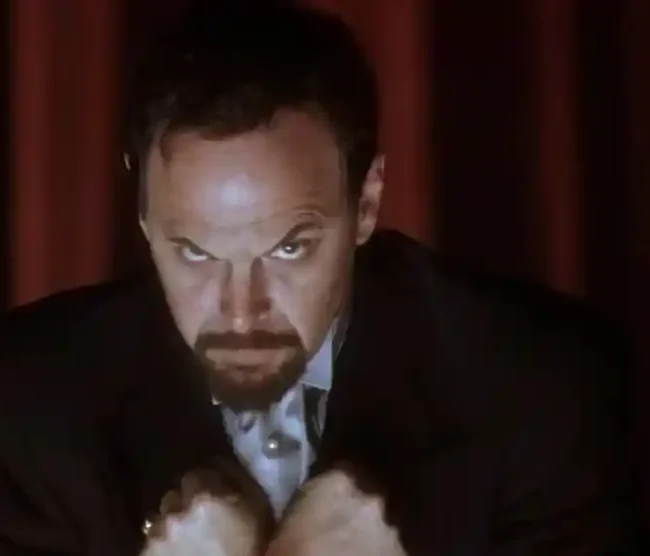A Conversation with the Cast & Crew of SEW TORN
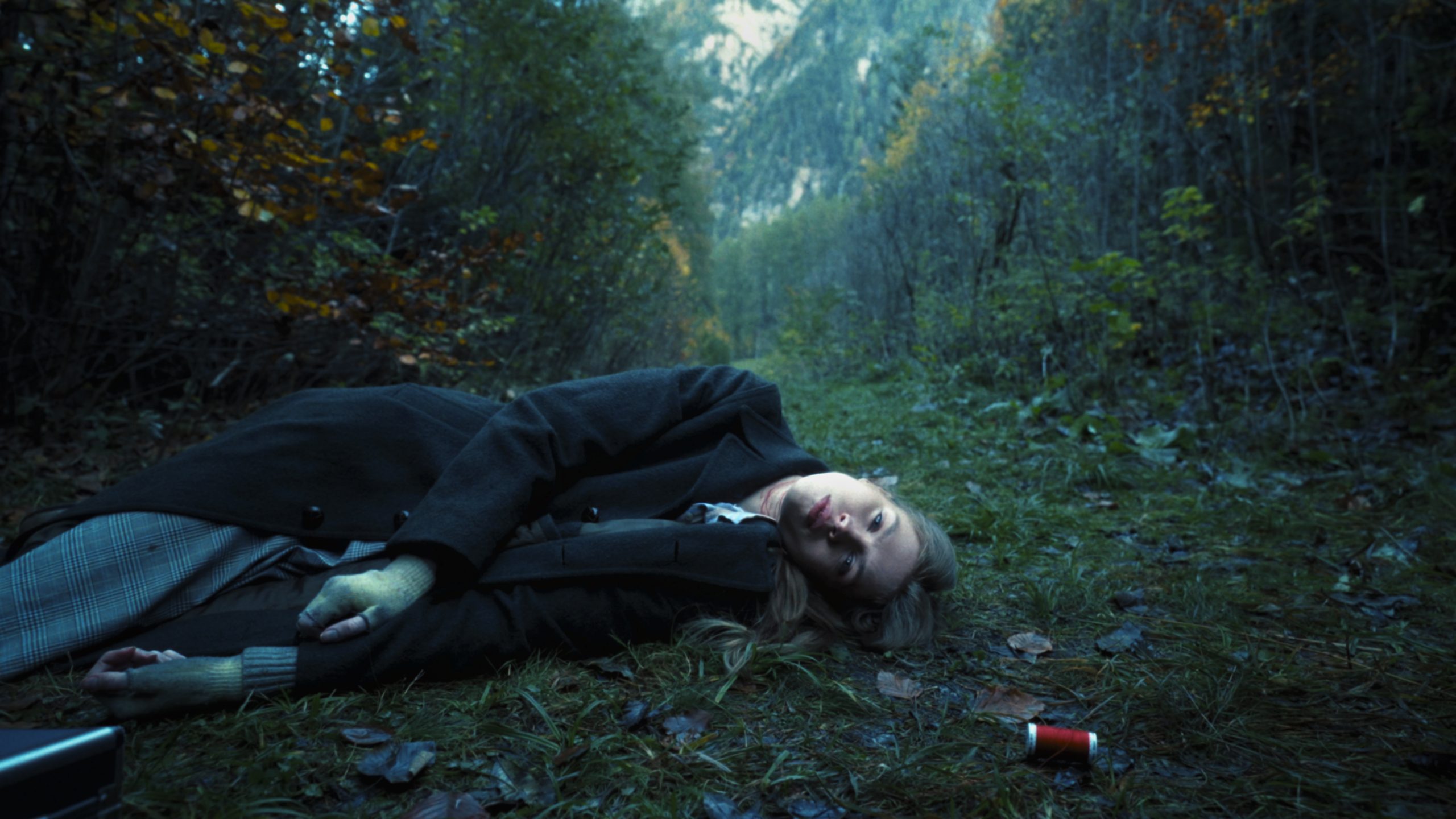
(Editors note: there are possible spoilers within this interview…proceed with caution!)
Sew Torn is a refreshingly original thriller that defies easy categorization, blending dark comedy with neo-noir sensibilities in a way that feels both familiar and completely unique. Directed by Freddy Macdonald in his feature debut, the film follows Barbara Duggen (Eve Connolly), “The Mobile Seamstress,” who stumbles upon a drug deal gone wrong while on a seemingly routine errand to replace a lost button. What makes the film truly distinctive is its tri-part structure—presenting three different scenarios based on Barbara’s crucial choice: commit the perfect crime, call the police, or drive away. Set against the stunning backdrop of the Swiss Alps, this intricate thriller uses thread and needlework as both literal tools and powerful metaphors, creating elaborate “Rube Goldberg-esque” contraptions that become central to the story’s ingenious plot mechanics.
The film boasts an exceptional international ensemble cast that brings depth and authenticity to this twisted tale of choice and consequence. Eve Connolly delivers a captivating lead performance as Barbara, a grieving seamstress trying to save her late mother’s fabric shop while grappling with profound loss. John Lynch brings menacing intensity to Hudson Armitage, the story’s primary antagonist whose relentless pursuit drives much of the film’s tension. Veteran actresses Caroline Goodall and K Callan provide memorable supporting turns as Grace, the demanding bride-to-be whose lost button sets everything in motion, and Mrs. Engel, the local cop who serves as both wedding notary and law enforcement. Calum Worthy rounds out the central cast as Joshua, the conflicted son caught between family loyalty and moral conscience. Together with director Freddy Macdonald, these performers have created something truly special, a film that premiered at SXSW to rave reviews and promises to establish its young director as a major talent to watch.
John Lynch (Cast) & Eve Connolly (Cast)
Hammer To Nail: Thank you both so much for taking the time to speak with me. I thought the movie was excellent, and your chemistry was such a major part of that success. The film has a unique structure, showing three different potential outcomes for Barbara’s choices. How did that narrative approach affect your performances, particularly in trying to maintain emotional continuity across these parallel stories?
John Lynch: I think for Eve, it might have been more complicated than for me. In each scenario, I’m chasing, and things go more or less according to plan. But Eve is the constant throughout all three stories. For me, I had one clear agenda in each story: get the case back. If I couldn’t retrieve it, I’d kill her and whoever got in the way. Those are pretty obvious signposts to follow. For Eve, the challenge was much more involved.
Eve Connolly: Well, Freddy the director really understood Barbara’s arc for each individual story, but also the overall arc of the film. He knew exactly when we needed to hit certain emotional beats. There’s a scene between me and Calum in the police station in the second story that’s actually crucial for Barbara’s overall journey, because over the course of the film, she’s realizing things about her own life. She has that journey throughout, but each time she also starts again fresh.
That was initially a concern for me, but Freddy was so confident about what he needed from each scene. I knew that if he felt we got what we needed and he had the overall vision in mind, then I had done my job. I kept it in the back of my mind but didn’t let it stress me out too much, because I could get worked up about that kind of thing. It was really about trusting Freddy and knowing he understood where the overall arc was heading.
HTN: The press notes mentioned that you learned to make Barbara’s dart gun at home. Can you talk about the physical preparation for the role and mastering the various thread schemes that are so central to your character?
EC: That was definitely a major concern for me because I had never sewn before, and I wouldn’t have considered myself particularly good with intricate, finicky work. I don’t play instruments or anything like that, so I was nervous. But before filming, Freddy sent me a series of videos with him and his dad, Fred. They basically demonstrated everything that Barbara does in the movie. They went through every trap she sets up and made videos showing exactly how to construct the guns and execute each technique.
I would sit at home, watch those videos, and practice doing exactly what they showed me. It was really just them figuring out how to make all those traps and mechanisms work in their house, and then I copied their methods.
HTN: The film was shot in Switzerland with an international cast. How did that setting influence your performances, and what was it like working with such a diverse ensemble?
JL: Do you remember that cliff in Bad Ragaz? That perpendicular moment—
EC: When I almost drove off? Oh my god, yes. It felt surreal, like it didn’t look real, like a postcard. You’d get caught up in the work you were doing, and then occasionally you’d look out and think, “This is incredible what we’re looking at here.” I think the setting really helped establish the tone of the film. It has a very particular, original tone, and everything contributes to creating that world. The scenery and setting were huge parts of building that atmosphere.
The people were so lovely too. The crew on this film was just wonderful. The two women doing hair and makeup, every morning we’d be singing songs together. They were just delightful people, and it made the entire film feel fun from start to finish. Everyone was there because they cared about the project, and I think that comes through in the final product.
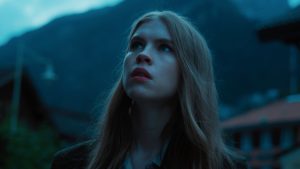
Eve Connolly in SEW TORN
JL: The landscape is immense in this story. It fits the heightened, exaggerated, pushed world that we all exist in, where everything is deformed and misshapen. Nothing quite fits in its box, and I think the landscape captured that perfectly.
HTN: The film blends thriller with dark comedy elements. What was the most challenging scene for each of you to shoot, particularly in balancing those tones?
JL: The diner scene for me. Within the story, that’s Hudson Armitage’s defining moment where you learn the history between him and his son, and understand the stakes at play. When I first got the script, I went straight to that scene and then to the shooting schedule to see when we’d film it. There’s always one or two scenes that you know are definitive—they define something about your character and the world.
That was my pivotal moment, especially because of all the dialogue. It’s a five or six-page scene, and then it culminates with Eve’s amazing dance. That was the most important, glorious day for me on the shoot. Eve’s dance, our scene together, the scene with Calum, everything coming together. It was wonderful.
EC: Honestly, in terms of balancing comedy and drama, I approached it similarly. There were certain scenes that were important for Barbara’s emotional arc, and those were the ones I’d be anxiously waiting for and nervous about. I was particularly nervous about the dance scene.
But regarding the humor, I think much of it is visual, which makes it easier to understand and gives you a lot to work with. Also, the other actors really helped with that balance. Working off of them made it automatic. In my scenes with John, I wasn’t worried about how I was acting because I was just reacting to everything he was doing, and I was terrified.
Similarly, the first scene I shot was with Ron, and he brings so much humor and spontaneity that playing off of him really helped me. Everyone around me made those challenging elements easier and allowed me to intellectualize less and just be present in the moment.
HTN: Your first sequence together ends horrifically with John using yarn to strangle Eve. It’s a very intense scene that really cuts through. Much of that impact comes from both your performances. Talk about your approach to that moment.
JL: I was a bit worried about it. It was very dark, nearly dusk, and I’d been chasing Eve through the woods. Then I had to strangle her with this very fine cord and make it look credible without actually putting pressure on her neck. It was challenging because Eve had to trust me, and I had to be careful not to apply too much force, plus, if I did, the thread would break. It had to be calibrated so it appeared credible without losing the aggression or intensity.
EC: Those scenes are more difficult for the person doing the strangling because the responsibility weighs on them to sell it while ensuring safety. For me, I could focus more on the performance and being in the moment because I knew John would never actually hurt me.
JL: By the end, we were actually laughing because we’d run so much. I decided to wear my own boots, which are very heavy, because I wanted them to have solidity. But they’re not made for running through woods, so I ended up caked in mud with thread hanging off every part of my body from all the takes we did. But it was great fun.
EC: That’s my main memory too. It was really fun. All those intense scenes were genuinely enjoyable to film.
HTN: There’s a confrontational moment in the “call the police” timeline where John, you’re screaming at Eve before she electrocutes you, getting right up in her face. Talk about how that specific moment came to life.
JL: That rant was improvised. I don’t know why or where it came from, it just erupted. Afterward, I told Freddy, “I went somewhere and I don’t know what the fuck I said,” and he responded, “No, no, it was great. That’s exactly the right area. Keep going.”

John Lynch in SEW TORN
I remember how close I got to Eve and thinking, “Oh god, Jesus.” It wasn’t written that way, and I decided to completely upend the scene. I came in with much more aggression and energy because I had just shot Gareth. That’s actually my favorite moment, when she tries to reach for her gun and I shoot, then go straight into that confrontation. I decided to do something different, and Freddy went with it. It ended up giving that scene a really powerful opening.
EC: It was amazing for me because he was terrifying in the best possible way. It was completely unexpected and I think it elevated the scene significantly.
HTN: Eve, your dance is incredible, and John, your reaction to it is equally hilarious. Talk about working with Freddy to construct that moment.
EC: Freddy obviously knew what needed to be set up in terms of the thread pattern on the ground, so he walked me through the specific areas of the restaurant I needed to hit during the dance. But he was very clear that he didn’t want it to look choreographed at all. He didn’t want Barbara to appear as if she was a trained dancer in any way.
We didn’t do any rehearsal, and there was no formal choreography. Instead, he explained the vibe of the dance and what we were aiming for, then just said “go.” I think we did maybe two takes of just going completely wild with it. We focused more on discussing the emotional journey of the dance rather than planning specific movements. There was no rehearsal or predetermined plan other than knowing which spots to hit.
JL: I just used what I saw Eve do the very first time and stayed with that reaction, which was pure amazement. I was completely impressed and bamboozled, which was absolutely the right response for the character. I stayed in that headspace throughout the scene.
Caroline Goodall (Cast) & K Callan (Cast)
HTN: Thank you so much for taking the time to speak with me. I thought the movie was amazing and your performances were exceptional, so I’m very excited to be discussing this. Both of you have had incredible career longevity in this industry. What stood out to you about Freddy’s vision for Sew Torn that really made you want to be part of this project?
Caroline Goodall: I got sent the script, unlike K who has actually worked with Freddy three times and has really nurtured his career. I read the script at a stage in my life where it’s really enjoyable to choose what you want to do. I’m particularly enjoying working with younger directors at the moment because they have such vision and a way of working that’s nimble and versatile. I think it’s important for me to understand and learn from that approach.
There’s so much television happening right now, and we do a lot of that work. But the chance to do an independent film with Freddy’s kind of vision, he’s really unusual. Even though we keep mentioning how young he is, he’s actually a very mature film director in so many ways because he started so young. His vernacular is exceptional, and the characters he writes are fantastic.
I just read the script and loved it. Sometimes there are projects where you think, “I don’t really care about anything else, I just want to be part of this.” I really connected with Grace. She’s absolutely awful, and it’s genuinely fun playing absolutely awful people. There are maybe one or two moments of vulnerability, but not many. She completely believes she is who she is and that she has the right and entitlement to demand everything she demands.
What’s also interesting is that in this little Canton where they are, everyone is slightly displaced. You have Eve’s character trying to find her way, but actually they’re all trying to find their way. Within that framework, there’s this whole concept of choice and fate and free will, all wrapped up in quite a brilliant package with a bunch of thread. What could be more amazing than that?
K Callan: I always find this question amusing because unless you’re a star, it’s not like you have endless opportunities to work. This was a great script, and I did get to work with Freddy before, but I’m a working actor. I frequently think of stardom as just unemployment at a higher rate of pay. Not everybody works all the time, and when people do work constantly, sometimes audiences get tired of seeing them everywhere.
I was suggested to Freddy when he was doing his thesis film at AFI, and I got to work on that project with him. He ultimately won a student Academy Award for it. While we were working on that, he and his dad, who write together and wrote Sew Torn together, mentioned there might be a part for me in their next project. They were still working on the script, so it went on and on. I would talk to them periodically, and they’d say, “Oh, it’s almost ready.” Then they finally called when it was ready.
What was so appealing was how much dimension the role had, it’s fun and layered. Also, Freddie and his dad are both wonderful people. I really enjoyed working with them and getting to know them. They’re terrific human beings.
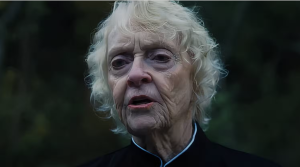
K Callan in SEW TORN
HTN: The Swiss setting creates a unique backdrop for the story. How did filming in such a picturesque location influence your performances, and did either of you get to explore the area during production?
CG: It was wonderful. We were really in Heidi land. Bad Ragaz is actually a very old spa town with natural hot springs, so we were able to take advantage of that as well. Those springs produce incredibly hot water, and you can actually hike right up to the source, which was used in medieval times by pilgrims coming to take the waters. It’s a really special place up in the mountains, and we shot there.
Because Freddy has this connection with Switzerland and had worked with crew members before, along with his DP, they’d found this little location with an empty school. They converted it into a production office where half the crew also slept. We had our makeup done there and used it for the sheriff’s headquarters and other locations. That little café we used was literally just down the road.
They created an environment that was like a mini studio up in the mountains, which was blissful for us because we weren’t traveling far. Everybody ate together and hung out together, it was the proper way you actually want to work, which you don’t often get the chance to experience. I think that’s a direct result of who they are as people and how they work. Freddy works with his dad, they’re very family-oriented, and the whole feeling of the film reflects that family orientation.
We as a cast and crew really felt that way too. So much so that half the crew flew out for South by Southwest, and we all stayed in places either next door to each other or together. We did everything together, and it was just fabulous.
KC: First of all, I got to go to Switzerland, which was fantastic. The short film on which this feature was based was shot there because Freddy was living there when his father moved there for work, and Freddy attended high school there. We were lucky that’s where the story originated and where we got to film.
The short film managed to catch the attention of the Coen Brothers, who became big fans of Freddy and invited him to lunch. They’ve been mentors to him along the way, and he ended up with their agent as his agent. He’s really moving along in very good company.
My daughter came for a few days during filming, and we got to drive around and see more of Switzerland than we might have otherwise. Then we got to go back because last summer we were at the Locarno Film Festival and saw even more of the country. I hope we’ll have lots of sequels so we can keep returning to Switzerland.
HTN: Caroline, you’ve worked as a screenwriter, and K, you’ve written several books about the industry. How has your work behind the camera or as an author influenced how you approach roles like these in Sew Torn?
KC: My books aren’t the kind you might think they are. They’ve been for actors, writers, and directors about how to get work in the business, how to think about the industry, and how not to get too dejected when things don’t go right.
I think being in this business, you start out green and just hope for the best. Then you learn something new every time you work. One of the great things about our business is that it’s freelance, you keep going to different places, meeting new people, and learning constantly. Although I’ve also written scripts, which is different, I think it’s all part of the same thing. Everything you do every day informs what you’re going to do today and tomorrow.
CG: K is an incredibly wise human being and also has perfect comic timing. I think as you move along in the business, you find yourself interested in other aspects because actors see everything. We work with every single department, whereas sometimes departments only work with certain people. We see and learn everything.
If you’re interested, you naturally want to try your hand at different things. In terms of writing, I went to university to be a writer and found myself as an actor instead. Writing has always been my happy place. Something I do naturally. Then I became interested in film financing because it was getting so difficult, and I was curious about why particular films get made. I started learning about that and decided to put it into practice to see if I could produce and write. I really enjoyed it and am trying to do more of that. At the same time, when I do act, it’s like sinking back into a warm bath. I really love it.
HTN: Caroline, I love the sequence at the seven-minute mark where the button goes into the crate. Your delivery of lines like “at the shop” and “you stupid girl” are not only incredible but perfectly situated within the tone of this world. What was your thinking here?
CG: The tone was something we really discussed with Freddy extensively because while it comes off the page, you have to be so careful, that balance has to be precise. You have Eve’s character plowing her own furrow, and then you have these other characters who are almost operatic at times. You have to reach that level because otherwise the comedy isn’t going to work for the subsequent sequences.
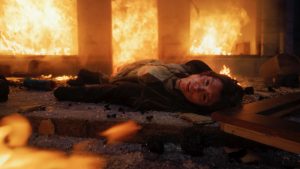
A still from SEW TORN
We were constantly talking about tone, especially in that scene with K when I’m getting married and there are people next door. She’s going in and out, and she’s extraordinary because she plays it so brilliantly. But unless you have a Bridezilla who’s going a little crazy as well, some of that material won’t work.
It was fun, but I really loved that scene with John Lynch when I walk in. I actually said to Freddy, “Can I just play this like I’m a gunslinger?”
HTN: K, your introduction as the cop is so well done. There’s not much dialogue, but it all works because of your amazing physicality and hilarious facial expressions. Talk about your thinking in that moment. I also love the car scene when you say “you have your whole life in front of you.”
KC: I love that scene so much. the whole sequence with the guys on the ground and getting to pull my gun. The writing is so great, and as an actor, you can’t be great unless you have good material. When you have really good material, it just plays itself. This was such a gift to get to do. Coming in and being John Wayne meets Sherlock Holmes.
CG: I think Freddy and his dad are really fine writers. But Freddy’s vision of the world is so offbeat and quirky, and that really compels you. I think it’s wonderful to have a movie like this. When we showed it at South by Southwest, everybody came up to us and said it blew them away because it was so different. We’re so used to just variations on the same themes going round and round. What Freddy has is so fresh. I think he’s got a wonderful career ahead of him, and it’s lovely to be part of it at these early stages. I’m very keen to see what he does next.
HTN: K, shortly after this you have your monologue trying to get someone in that room to be honest and not go to jail, which continues into you saying “Do you think your father would approve of your actions?” Such great lines.
KC: I shot that on my very last day, and it was much longer than it ended up being because they had to cut for time. It was quite long and didn’t all flow together. it was just thoughts that would come up organically. Throughout the whole shoot, I was thinking, “Please, let us get to this day,” because it was on my mind the entire time.
Shooting it was so nice because most of it was delivered to Calum, who is a really terrific actor to work with and incredibly empathetic. He was really there for me. Even though it was a monologue, it felt like a conversation rather than just performing alone. It was really enjoyable. The words were so great.
Freddy Macdonald (Director) & Calum Worthy (Cast)
HTN: Calum, what attracted you to the role of Joshua, and Freddy, what qualities were you looking for when casting this character who’s caught between family loyalty.
Calum Worthy: What drew me to the project was Freddy. I was a huge fan of the short film that the feature was based on. I had the opportunity to work with Freddy on another short film called Shedding Angels. I was able to witness his great mind on set. I told him at the end of the shoot, “Who do I have to bribe to be in the next thing you make?” When he told me it was a feature version of Sew Torn, I was so excited because I was such a genuine fan. I remember, it was during covid, I was telling all my friends to sit down and watch the short. They all became obsessed with the short, so when I told them I was doing the feature length version, it was like I was doing Star Wars.
Freddy Macdonald:. It was a very easy decision for me because I wrote the role for Calum. Like he mentioned, I was lucky enough to work with Calum on my AFI thesis film. We had a fantastic time and it was so kind of him to take a chance on me as a student. Luckily, our agents at UTA connected us and made it happen. For the feature I knew Calum would be perfect for it. He is such a dynamic actor. The character has to go through a lot. He is playing three different narratives. He had to balance a schedule that was fluctuating between the three narratives. The constant physicality of having endured this drug deal gone wrong, and the emotionality of his father’s watchful eye. The role required so much and I knew Calum would nail it.
CW: He also forced me to go to Switzerland …Which was so hard haha …no it was actually stunning… The shoot locations. Every day I was like “I feel like this place is AI ….how is this real?”
HTN: The film was shot in Switzerland but takes place in a somewhat ambiguous setting. Freddy, what was your vision for this quasi-European world, and Calum, how did that setting influence how you approached your character?
FM: My mom is half Swiss. We all have Swiss passports and I went to high school in Switzerland. When I was there, I tried to immerse myself in the Swiss film industry as much as I could. It is very small, so I got to know everyone super fast. I met my incredible cinematographer Sebastian Klinger there. We started making short films and Sew Torn was the last one we did. I love shooting in Switzerland because it was so different from anything I had experienced in LA. Everyone in the town opened up their doors to us. Even months before production, they were letting us take pictures and giving us gifts just to shoot in their homes. So from a production standpoint, it was a dream. I also love films that create a fictitious world that is heightened and hopefully allows us to get away with more like the Goldberg rigs. Those were done practically but still require suspension of belief. I love Wes Anderson’s work and how he gets away with that.
HTN: Freddy, you directed elaborate thread contraptions for the film. What was the most challenging technical aspect of shooting these scenes for each of you?
FM: It was a constant headache for my Dad and I. Calum and the actors were very kind in not questioning the absurdity of my Dad and I running around pulling guns on the floor with thread and shooting things in a very stop-motion-esque manner. We knew it would work because we tested it all before but it was always stressful with our time constraints. We did not know if we would be able to get the shots we needed. It was about finding that balance because I could not spend too much time on these gun inserts. I needed to tell a greater story, that was what was most important. It did not help my stress that I was also the editor and the script supervisor haha.
HTN: Freddy, your father Fred is both co-writer and producer on the film. How did that father-son creative partnership work in practice, and how did it evolve from your earlier collaborations to this feature?
FM: My dad taught me stop motion animation when I was 9. I was always animating stupid things and then one day he said, “No, you should tell a story with a beginning, a middle and an ending that subverts expectations.” That was instilled in me since I was a kid. Ever since that point we have been co-writing. We have the same taste because he showed me all the movies that I love. We never have disagreements about what’s on the page. We have disagreements, when I am editing the film for 10 months and he comes in as the fresh eyes and picks it apart. That is when we butt heads. In terms of pre-productions and productions we are very aligned in how we work.
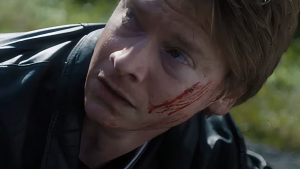
Calum Worthy in SEW TORN
HTN: I love this sequence in the call the police timeline where K is interrogating the three of them and gets up in Calum face and says “Do you think your father would approve of your actions?” Your reaction and line delivery here is excellent. What was your thinking for this moment and same for Freddy.
CW: I was just reacting to K. Her performance is so powerful. She is an amazing actor. When you are working with other great actors, the job is so much easier. When John is yelling at you, it is easy because he is doing all the work, I just have to live in their world. That was the amazing thing Freddy did. He put together an ensemble that was so interesting. It’s full of actors that have done such great work in the past on so many different kinds of projects. Bringing people from all different places and upbringings in the industry, it creates this mosaic where people come with their own version of the craft that they have learned. Together that creates magic.
FM: That scene was a lot of fun for me because Calum and K worked together on my short film! It was a very different set up, but the dynamic was similar in that Calum is passive in that moment as K continues to hit him with questions. I had no doubt they would have great chemistry.
HTN: I cried laughing when John tell Calum to say, “Hi,” to Babs and they both let out the faintest most pathetic, “hi,” and John goes, “What are you a fucking mouse?” talk about that specific moment and how it came to life.
FM: I can say that moment was entirely improvised. John and Calum were both very much embodying their characters throughout the entire shoot. They were both so in it that there would be these moments, like this one, where I was just trying not to laugh when I was off camera with my monitor.
CW: John is incredible. I do like to stay in character to stay in the moment. Mostly because I want it to be great and I don’t want to leave the head space. John is a similar way where we did not really talk much outside of the scene. Afterwards we hung out and grabbed a beer. That was really fun, but before that, the whole day we did not really engage too much. We stayed in our own world. It was really nice because I got to know him as the character first. That was a great situation to be in because it made it so much more real.
HTN: The moment in the bathroom is so well done. It’s a nice moment of revelation for these characters and surprisingly searing drama. For both of you what was important here.
FM: That was a scene I was nervous for. It is a moment of breath in otherwise a non-stop rollercoaster ride. I was not nervous at all about Calum’s performance. I knew he was going to hit it. I just wanted to give Calum space to do it in longer takes to have that moment of breath. I was also thinking about the rest of the narrative and how it mostly has a very insert based type of storytelling. I wanted to maintain that tension. Once we started shooting it I wanted to elongate the scene because Calum was so in that world. We were shooting at a real Swiss diner. I felt bad for him because the radiator was extremely hot. We were all very sweaty there haha.
CW: I’m a germaphobe so I was just nervous about the bathroom floor. Freddy and Sebastian work in a very unique way. You feel like you are doing choreography with the camerawork, but it’s not distracting. It does not take you out of it. I was so into it. You have to work with the camera which is very unusual. Generally, I feel like I am in silos but what I loved working with this team is that it felt like a true ensemble in front of the camera and behind the moment. Even in an emotional moment we are all working together.
HTN: The moment right after you have shot John is so great. We cut to you, not Eve, and we watch as you have a half smile…it’s such a piercing moment and a great performance. What was the thinking?
CW: That was all Freddy.
FM: I was going to say that was all you!
CW: It is a big moment for the character. Freddy very quietly, it felt like it just entered my brain, he whispered, “it’s done…it’s over.” It was exactly what I needed to hear. I felt like I was emotionally connected to the camera and the director at the same time. Again, being able to work all as one was so special.
FM: We were rolling for about 15-20 minutes just in that very intimate close up of Calum. He is the one who is also pulling the thread for the gun. It’s a very physical action pulling the gun and we elongated it to really get to a place of feeling like this is really going to happen. He is really going to kill his father. Right after it happened we just rolled on Calum. I knew he would deliver what we needed.
CW: The crew was amazing there because they knew it was emotional. It was a very heavy moment and we needed to get it right. I remember walking on set and feeling like everyone was there for me. Every department was like, “we got you…we just want this moment to be great.” I was very grateful for that. The crew was unbelievably respectful and really helpful in the process. It felt like I had everything I needed. It was so easy. You don’t always get that. This was a unique crew that was dedicated to making this happen. It was not about any one person. It was about the collective storytelling experience. I want to work with this same crew over and over again because it was a real dream team.
– Jack Schenker (@YUNGOCUPOTIS)

